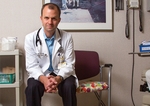AMA House of Delegates

Washington State Medical Assn. President Doug Myers, MD, says many physicians choose not to become board certified. He urged the house to make a strong statement that no doctor should lose a license for not being board certified. Photo by Ted Grudzinski / AMA
Don’t make licensure dependent on board certification, AMA says
■ Delegates adopt policy urging medical boards to establish flexible medical license requirements that benefit — and don’t harm — physicians.
Chicago For years, the Federation of State Medical Boards and individual medical boards nationwide have been developing new standards for maintenance of licensure. Many physicians are concerned that those requirements could create undue burdens of time and money on doctors and duplicate what they already do to maintain board certification.
The American Medical Association wants to ensure that those mandates don't become burdensome and says no doctor should be barred from practice for not keeping up with board-certification requirements, according to policies adopted at the AMA Annual Meeting. The Association is urging allopathic and osteopathic licensing boards to develop alternatives for the estimated 200,000 physicians who are not board certified.
“We don't want [doctors] to lose their license because they don't have maintenance of certification,” said Washington State Medical Assn. President Doug Myers, MD, speaking on behalf of the Western Mountain States Caucus during the AMA House of Delegates meeting.
For physicians who are board certified, the AMA is working with the FSMB, the American Board of Medical Specialties and others to ensure that maintenance of certification and osteopathic continuing certification requirements are accepted as meeting MOL. On maintenance of certification, the AMA is encouraging specialty boards to consider other means of evaluating physicians beyond “high-stakes, closed-book examinations,” new AMA policy says.
Monitoring future impact
As new licensure and certification requirements unfold over the next decade, their impact on the physician work force is unknown, says a report by the AMA Council on Medical Education. Those efforts should be coordinated and not create such a burden that they make it difficult for nonpracticing physicians to re-enter practice, or encourage practicing physicians to retire early or transition away from direct patient care, the council said.
Expanding physician work force shortages make it particularly important that the AMA continue to monitor the situation, said Kelly Caverzagie, MD, an assistant professor of internal medicine at the University of Nebraska Medical Center who testified at the meeting on his own behalf. Shortages nationwide are projected to more than double from 62,900 physicians in 2015 to 130,000 in 2025, according to the Assn. of American Medical Colleges.
“As a society, we should work to understand this impact, if it even exists, in order to preserve access to adequate medical care,” Dr. Caverzagie said. “We must understand if these significant changes to physician self-regulation will contribute to the growing work force crisis and respond accordingly.”
The AMA's goal is to make sure that the evolving rules are flexible and add value to doctors' ability to care for patients, said Lynne Kirk, MD, a member of the AMA Council on Medical Education and professor of internal medicine at the University of Texas Southwestern Medical School.
“The requirements for MOC, OCC and MOL should be aligned, but these requirements are distinctly different processes, designed by independent organizations with different purposes and mandates,” the council report said.
The FSMB agrees, said federation President and CEO Humayun Chaudhry, DO.
“Ultimately, maintenance of licensure is something that would impact all of the nation's 850,000 physicians,” he said. “We feel that there should be a minimum burden to physicians. The goal of [MOL] is simply to support a physician's commitment to lifelong learning.”
Hospitals, insurers check certification
All doctors must have a medical license to practice. But participation in MOC and OCC is voluntary, although hospitals, health systems and insurance plans increasingly require physicians to be certified to be credentialed. About 78%, or 638,000, of practicing allopathic physicians are certified by one of the ABMS' member specialty boards. Nearly 40% of osteopathic doctors are certified by one of the 18 boards of the American Osteopathic Assn.'s Bureau of Osteopathic Specialists, according to the Council on Medical Education report.
Dr. Chaudhry emphasized that the FSMB has no plans to force physicians to be board certified.
“We will not be requiring specialty certification, maintenance of certification or osteopathic continuous certification as a condition of licensure,” he said.
For those physicians who are board certified, the FSMB has been working with the ABMS and its 24 specialty board members to ensure that MOC and OCC requirements will be taken into consideration as part of MOL, he said.
Exactly what will be required under MOL will be up to individual state boards, but the FSMB is working to develop standardized guidelines to help in the process, Dr. Chaudhry said. Similar efforts are under way in other countries, including the United Kingdom and New Zealand.
“We have 70 state [allopathic] and osteopathic [medical] boards, so it doesn't make sense to have 70 different maintenance-of-licensure processes,” he said.
This summer, the FSMB will launch pilot projects with 11 boards around the country. Some will collect data on the types of educational activities physicians already are engaged in, while others will report on board resources needed to implement new MOL requirements. More pilot projects probably will begin next year, Dr. Chaudhry said.
It will be some time before most states implement new MOL rules, said Lance Talmage, MD, chair of the FSMB board of directors.
“This is not something that is going to be in full force for five to seven years, so there is time to look at it,” Dr. Talmage said.
Carol Berkowitz, MD, a member of the AMA Council on Medical Education and a pediatrician from Rancho Palos Verdes, Calif., said the council plans to continue monitoring maintenance of licensure and certification rules and their impact on the physician work force.
“These are still evolving areas,” Dr. Berkowitz said.












